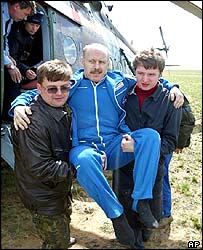A storm of emotions accompanied the loss of contact with the Soyuz and the two hours that passed until the crew members were found safe and sound
 It is a difficult experience that the head of NASA hopes not to experience again, certainly not three months apart. However, when communications were lost just minutes before the Russian Soyuz cabin that returned three people from the International Space Station touched down, Sean O'Keeffe relived the morning Columbia was lost.
It is a difficult experience that the head of NASA hopes not to experience again, certainly not three months apart. However, when communications were lost just minutes before the Russian Soyuz cabin that returned three people from the International Space Station touched down, Sean O'Keeffe relived the morning Columbia was lost.
"It was hard to believe what happened," said O'Keefe.
Unlike in the case of the Columbia disaster, when NASA knew within minutes that the shuttle had disintegrated over Texas, the event this time, on Sunday, May 4, was different. The search took two hours.
There was great anxiety, no doubt about that, said O'Keeffe, who watched the event from the Russian control center near Moscow.
O'Keefe expressed his feelings in exaggeration when the three - the Americans Kenneth Bowersox and Donald Pettit and the Russian Nikolai Budarin - were found safe and sound in Kazakhstan, about 400 kilometers from where the Soyuz was supposed to land.
NASA is participating in the investigation as to why the Soyuz entered a steep ballistic trajectory and exposed the crew members to tremendous gravitational forces and also landed so far from the target. A committee consisting mainly of Russian space and aviation engineers was formed on Monday to look into the matter. Initial evidence indicates that it is probably a computer malfunction. "It looks like some kind of technical glitch with the new version of the Soyuz," O'Keefe said after meeting with his Russian counterpart Yuri Koptaev. "But not everything was out of the ordinary."
The new model, whose improvements were made at the request of NASA so that it could accommodate astronauts with a larger body structure, made its test flight with regard to reentry and landing.
The Soyuz was launched to the space station six months ago as a rescue boat. (The Russians would perform a round in which they would send two cosmonauts to assist the station crew members for a week and they would return in the older spacecraft. The third place was reserved twice for space tourists who paid 20 million dollars each). The Columbia disaster and the grounding of the fleet forced the space station crew to return in a Soyuz instead of the Atlantis shuttle after a five and a half month mission.
On Sunday, the CEO of the Energy company, which manufactures the Soyuz, Yuri Semyonov, told Russian television that one of the Americans must have pressed the wrong button. The next day he corrected himself and said that the fault may lie with Budarin, who was indeed a flight engineer, but not a pilot - he pressed the button directing the ballistic entry. He said the cosmonaut assured him he didn't touch any buttons. Soyuz entry is an almost completely automatic process.
Bowersox said the computer readings suddenly shifted from those of a normal entry to that of a ballistic entry. The only way to do it manually is to press a button on a handle, and Budarin had access to all of those buttons and didn't touch them, so they weren't accidentally pressed, the American said.
"I don't think we did anything to cause this to happen," Bowersox said in an interview with NASA television. O'Keefe agreed with the statement that the team should not be blamed.
Semyonov promised that the findings of their test will be given in June, when the spacecraft arrives at the company's center in Moscow, the engineers will test it then, he said.
In any case, O'Keefe promised that among the equipment he will send to the current crew on the station, and who are also planned to return in a spacecraft of this model, will include a satellite phone that will also contain GPS. That way they will be easy to locate. It is hoped that the two will not forget to fill the battery.
Sunday's blackout began immediately after Budarin reported that the main chute had opened 16 minutes before the scheduled touchdown. This was the last call from Soyuz. Coincidentally, this was exactly the time of the last communication with Colombia.
The silence after that intensified. The time to touch the ground has come and gone and still not a word from the space people. An hour passed, and another hour when it was not known whether they were dead or alive. Helicopters and rescue planes scoured the smooth surface and barren steppes of northern Kazakhstan.
Everyone was happy when the cabin was found and it turned out that the three were outside and waving to the pilots (by the way, it took about an hour and a half until Budarin was able to open the door).
"You're certainly not in a state of trauma, physically or mentally, if you're out there waving to an airplane," said Dr. JD Polk, a NASA flight surgeon. The happiest were the wives of Bowersox and Pettit, who, along with one of Bowersox's younger brothers, were concentrated in the control center in Moscow during the entire event.
"They were the luckiest people beyond words," O'Keeffe said. Bowersox's wife said in an interview: "We knew it would take some time, but they would be found healthy."
